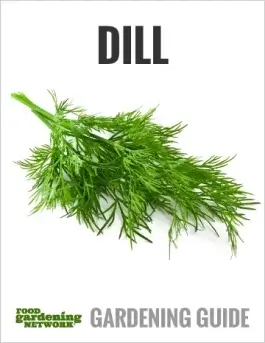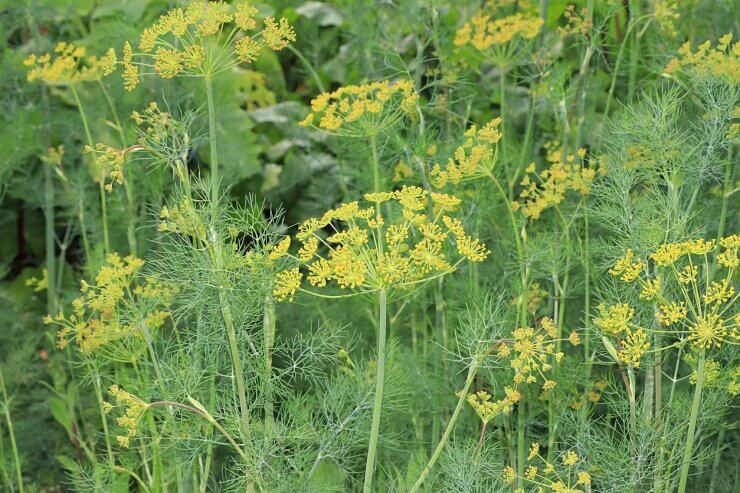
Once it starts growing, there are a dozen uses for dill – some modern, and some have been used for centuries.
Ah, the distinctive aroma and flavor of dill. Grassy with a hint of anise and caraway, every part of this plant is edible. Beyond food, dill has been valued for centuries as a digestion aid, a breath freshener, and protection against witches! Dill will also attract butterflies to your garden and seeds can be used in soapmaking. There are so many uses for dill!

Plus, it’s a breeze to grow. I’ve never had any troubling getting dill to grow and it is particularly beautiful when it begins to flower, although that does mark just about the end of its lifecycle, and it will begin to die back soon after if you don’t start using it up. So with that said, how does one use up their dill while it’s still ready for harvesting?
You can start harvesting dill leaves once the plant is about 8 inches tall, and thereafter as you need it. Continually harvesting of leaves over the course of the growing season will result in a fuller plant and help keep the dill from bolting and going to seed early. Once harvested, here are 12 ideas for using dill at home:
1. An herb and a garnish. This feathery garden favorite with lacy, umbrella-like heads can be used in leaf form or seed form to flavor a multitude of dishes. Dill leaves are often referred to as “dillweed.” Dill is a favorite herb in salads, soups, and stews, pairing with seafood, as a garnish. Many uses of dill popular in the US can be traced to immigrants who brought their favorite recipes and traditions with them. Greeks love their dill with beans, Russians pair it with beets in borscht, Scandinavians are partial to dill with coldwater fish, and South Asians savor theirs with yogurt, just to name a few examples.
2. Pickling. Perhaps dill’s most popular use—at least in the US—is in making dill pickles. Americans consume more than 2.5 billion pounds of them each year, with kosher dills being the favored variety. Dill has also been used in pickling other vegetables, like dilly beans!
3. Seeds for next year. As fall approaches, the flowers will be spent, the stems will dry out, and the seeds will turn golden brown. This is the time to harvest the seeds. If you wait until the plant dries completely and the seeds turn dark brown, the heads will release the seeds into the garden. This means you will gain volunteer dill plants the next spring, which is delightful, but you will lose the seed harvest.
4. A substitution for fennel: Dill and fennel taste similar, and you can swap one for the other in recipes, but keep in mind that dill has a milder flavor. The same is true for dill seeds and caraways seeds.
5. Medicine. Dill has been used as a medicinal treatment for centuries—as a digestive aid, a cure for hiccups, a sleep aid, and even an aphrodisiac! Many cultures sought out dill as a stomach soother and anti-flatulent. In fact, the word dill comes from the old Norse word dylla, meaning to soothe or lull.
6. Appetite suppressant. Puritans and Quakers gave their children dill seeds to chew on as appetite suppressants during long church services, leading them to be called “meetinghouse seeds.”
7. Milk production. Dill seeds are considered a galactagogue, meaning they can be used to encourage milk production in lactating women. If you look at the ingredients for nursing teas, you will often find dill seeds in the ingredients.
8. Breath freshening. Dill seeds can also be used to freshen breath, much like mint. You can chew the seeds or make dill tea.
9. Trap crop. If you’re growing tomatoes, dill is considered a trap crop for tomato hornworms, which means if you plant dill near your tomatoes, the hornworms will go to the dill instead because they like it more, and “trap” them.
10. Companion plant. Dill offers benefits to many garden plants. It improves the production of vegetables in the cabbage family, attracts beneficial insects such as honeybees. Dill also grows well alongside strawberries, fruit trees, sweet peppers, chilies, and thyme.
11. Pest repellant. The aroma of dill is said to repel aphids and spider mites.
12. Good luck! Ancient Romans and Greeks prized dill as a good luck symbol and a symbol of wealth, amongst many other things. Hey, it can’t hurt to grow it in your garden. Every garden needs a little luck!
Harvesting Dill
The best time to harvest dill is in the morning when the plants contain more moisture and taste the best. Don’t pull the leaves; use clean, sharp scissors or snips to cut the branches. Remember, all parts of the dill plant are edible, so don’t leave the branch stems behind, and feel free to pluck some of the flower heads for use in salads or garnishes in cucumber- or tomato-based drinks.
Should you cut more dill than you need, you can keep it safely in the refrigerator for 2 to 3 days after placing the stem ends in a container with water. If you have more dill than you can use over the growing season, you can dry it or freeze it.
If you liked this article on Dill, we have a whole gardening guide on Dill that you will love. Dill is one of the easiest, most gardener-friendly plants to grow and has dozens of culinary uses—every part of the plant is edible! Dill grows almost anywhere, the plant is both herb and spice, it’s not too picky about soil or water, and is bothered by few pests and diseases. In our Delightful Dill Gardening Guide you get all the details that go into growing and harvesting this aromatic plant. Get recipes for easy, savory dishes that make it all the more rewarding to grow your own dill. Get it all in our Delightful Dill Gardening Guide right now!


 Previous
Previous

